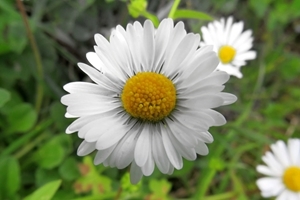Common daisy
 If we are looking for a symbol to reflect newfound positivity and hope in trying times, what better than a staunchly resilient, yet delicately pretty flower that is so familiar to us all: the common lawn daisy (Bellis perennis).
If we are looking for a symbol to reflect newfound positivity and hope in trying times, what better than a staunchly resilient, yet delicately pretty flower that is so familiar to us all: the common lawn daisy (Bellis perennis).
Trampled underfoot, hardly a second glance, I wonder how many of us have really looked at one since we sat on the school playing field as small kids to make daisy chains. I myself have certainly not appreciated until now their remarkable hardiness, their ecological role and their cultural significance.
Flowering year-round, their tiny cheery blooms can be found within a stone’s throw of you in any urbanised area, at Christmas or in midsummer, and you can’t say that about many plants! Opportunistic and thrifty, the lawn daisy is well-adapted to heavy vegetation management and difficult soil where most plants throw up their metaphorical white flag and surrender to a regime of mown grass.
Its commonness and familiarity explains why this daisy, whose name derives from the Latin for ‘pretty and everlasting’, is seen as the unofficial representative of all 23,000 species of daisy in the world. Daisy species make up roughly one in ten flowering plants on the planet and grow everywhere except Antarctica. Their umbrella family, Asteracae, is characterised by the unique make-up of the flower head, which appears to be one single flower but it is actually hundreds of tiny ones. In the case of our common daisy, these consist of yellowy orange ‘disc florets’ bunched together and surrounded by white ‘ray florets’.
A staple of lawns and amenity grasslands, the flowers offer a welcome source of nectar and pollen for small solitary bees, flies and beetles, and this importance is heightened when other flowers are absent. While the daisy doesn’t have a special relationship with one particular species of insect, it can help improve the overall biodiversity of a grassland or garden.
As well as playing an ecological role, it has had its uses to humans in recent and ancient history too. People are thought to have first cultivated daisies during early gardening activity in the early Bronze Age, and it was probably even further back than this when we realised they had medicinal properties and edible leaves.
The juice of the common daisy is full of astringent compounds. The Romans harnessed this herbal medicine by ordering that sackfuls of daisies be collected during war time and applied to soldiers’ spear and sword wounds to help close the tissue and stem blood loss. Henry VIII also famously ate daisies to cure stomach ulcers.
Most famously, however, the daisy has a long-standing place in European culture, particularly that of childhood because it is a symbol of innocence and purity. Petal picking ‘he loves me, he loves me not’ games are played to this day; daisy chains were once an essential part of dressing up for the village May Day; children still have daisy chain competitions at school. Plus, how many cows have been named Daisy?
Many of us will be waging war on daisies in the lawn with weed killer, or simply overlooking them as we tend our bigger, more exuberant blooms, so I hope this account of the dainty yet robustly spirited little daisy is enough to make you look at one twice!
Jess Brooks
Advisory
Photo credit: Anna Massini